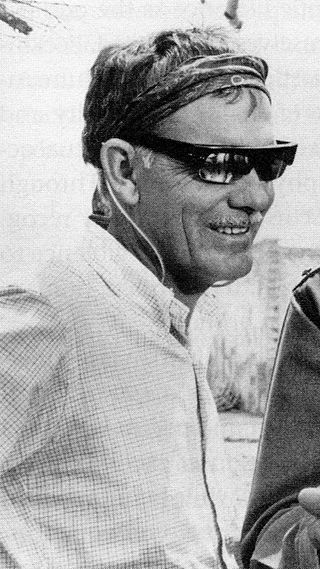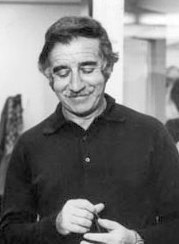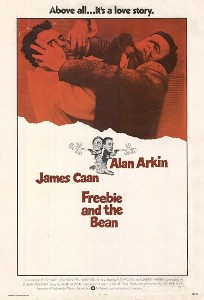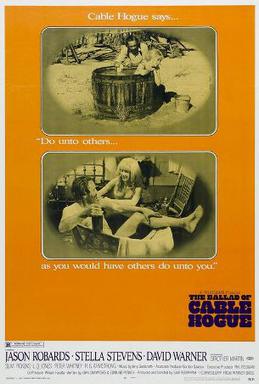
David Samuel Peckinpah was an American film director and screenwriter. His 1969 Western epic The Wild Bunch received an Academy Award nomination and was ranked No. 80 on the American Film Institute's top 100 list. His films employed a visually innovative and explicit depiction of action and violence as well as a revisionist approach to the Western genre.

Donald Siegel was an American film and television director and producer.

Straw Dogs is a 1971 psychological thriller film directed by Sam Peckinpah and starring Dustin Hoffman and Susan George. The screenplay, by Peckinpah and David Zelag Goodman, is based upon Gordon M. Williams's 1969 novel, The Siege of Trencher's Farm. The film's title derives from a discussion in the Tao Te Ching that likens people to the ancient Chinese ceremonial straw dog, being of ceremonial worth, but afterwards discarded with indifference.

Bring Me the Head of Alfredo Garcia is a 1974 Mexican-American neo-Western film directed by Sam Peckinpah, co-written by Peckinpah and Gordon Dawson from a story by Peckinpah and Frank Kowalski, and starring Warren Oates and Isela Vega, with Robert Webber, Gig Young, Helmut Dantine, Emilio Fernández and Kris Kristofferson in supporting roles.

James Edmund Caan was an American actor. He came to prominence playing Sonny Corleone in The Godfather (1972) – a performance which earned him Academy Award and Golden Globe nominations for Best Supporting Actor. He reprised his role in The Godfather Part II (1974). He received a motion pictures star on the Hollywood Walk of Fame in 1978.

Cross of Iron is a 1977 war film directed by Sam Peckinpah, featuring James Coburn, Maximilian Schell, James Mason and David Warner. Set on the Eastern Front in World War II during the Soviets' Caucasus operations against the German Kuban bridgehead on the Taman Peninsula in late 1943, the film focuses on the class conflict between a newly arrived, aristocratic Prussian officer who covets winning the Iron Cross and a cynical, battle-hardened infantry NCO.

The Getaway is a 1972 American action thriller film based on the 1958 novel by Jim Thompson. The film was directed by Sam Peckinpah, written by Walter Hill, and stars Steve McQueen, Ali MacGraw, Ben Johnson, Al Lettieri and Sally Struthers. The plot follows imprisoned mastermind robber Carter "Doc" McCoy, whose wife Carol conspires for his release on the condition they rob a bank in Texas. A double-cross follows the crime, and the McCoys are forced to flee for Mexico with the police and criminals in hot pursuit.

The Gambler is a 1974 American crime drama film written by James Toback and directed by Karel Reisz. It stars James Caan, Paul Sorvino, and Lauren Hutton. Caan's performance was widely lauded and was nominated for a Golden Globe.

Funny Lady is a 1975 American biographical musical comedy-drama film and the sequel to the 1968 film Funny Girl. The film stars Barbra Streisand, James Caan, Omar Sharif, Roddy McDowall and Ben Vereen.

Freebie and the Bean is a 1974 American buddy cop black comedy action film starring James Caan and Alan Arkin, and directed by Richard Rush. The film follows two offbeat police detectives who wreak havoc in San Francisco attempting to bring down an organized crime boss. The film, which had been originally scripted as a serious crime drama, morphed into what is now known as the "buddy-cop" genre due to the bantering, improvisational nature of the acting by Caan and Arkin. Reportedly, by the end of filming, both actors were confused by the purpose of the movie, not knowing that they had stumbled into a successful character formula. The movie was popular enough to spawn various other successful movie franchises such as,"Lethal Weapon", "48 Hours" and "Beverly Hills Cop." Loretta Swit and Valerie Harper appeared in support roles.

Convoy is a 1978 American road action comedy film directed by Sam Peckinpah and starring Kris Kristofferson, Ali MacGraw, Ernest Borgnine, Burt Young, Madge Sinclair and Franklyn Ajaye. The film is based on the 1975 country and western novelty song "Convoy" by C. W. McCall. The film was made when the CB radio/trucking craze was at its peak in the United States, and followed the similarly themed films White Line Fever (1975) and Smokey and the Bandit (1977). The film received mixed reviews from critics; however, it was the most commercially successful film of Peckinpah's career.
Stirling Dale Silliphant was an American screenwriter and producer. He is best remembered for his screenplay for In the Heat of the Night, for which he won an Academy Award in 1967, and for creating the television series Naked City, Perry Mason, and Route 66. Other features as screenwriter include the Irwin Allen productions The Towering Inferno and The Poseidon Adventure.

Pat Garrett and Billy the Kid is a 1973 American revisionist Western film directed by Sam Peckinpah, written by Rudy Wurlitzer, and starring James Coburn, Kris Kristofferson, Richard Jaeckel, Katy Jurado, Chill Wills, Barry Sullivan, Jason Robards, Slim Pickens and Bob Dylan. The film is about an aging Pat Garrett (Coburn), hired as a lawman by a group of wealthy New Mexico cattle barons to bring down his old friend Billy the Kid (Kristofferson).

Noon Wine is a 1937 short novel by American author Katherine Anne Porter. It initially appeared in a limited numbered edition of 250, all signed by the author and published by Shuman's. It later appeared in 1939 as part of Pale Horse, Pale Rider (ISBN 0-15-170755-3), a collection of three short novels by the author, including the title story and "Old Mortality." A dark tragedy about a farmer's futile act of homicide that leads to his own suicide, the story takes place on a small dairy farm in southern Texas during the 1890s. It has been filmed twice for television, in 1966 and 1985.

The Ballad of Cable Hogue is a 1970 American Technicolor Western comedy film directed by Sam Peckinpah and starring Jason Robards, Stella Stevens and David Warner. Set in the Arizona desert during a period when the frontier was closing, the film follows three years in the life of a failed prospector. While unmistakably a Western, the movie is unconventional for the genre and for the director. It contains only a few brief scenes of violence and gunplay, relying more on a subtly crafted story that could better be characterized as comedic in nature.

Robert Golden Armstrong Jr. was an American character actor and playwright. A veteran performer who appeared in dozens of Westerns during his 40-year career, he may be best remembered for his work with director Sam Peckinpah.
Takayuki Kubota, also known as Tak Kubota, is a Japanese-American karateka, known as the founder the Gosoku-ryu style of karate. He holds the title of sōke (grandmaster) for his development of the Gosoku-ryū, and is the founder and president of the International Karate Association. He is also the inventor and holder of the trademark of the Kubotan self-defense key chain.
Lou Lombardo was an American filmmaker whose editing of the 1969 film The Wild Bunch has been called "seminal". In all, Lombardo is credited on more than twenty-five feature films. Noted mainly for his work as a film and television editor, he also worked as a cameraman, director, and producer. In his obituary, Stephen Prince wrote, "Lou Lombardo's seminal contribution to the history of editing is his work on The Wild Bunch (1969), directed by Sam Peckinpah. The complex montages of violence that Lombardo created for that film influenced generations of filmmakers and established the modern cinematic textbook for editing violent gun battles." Several critics have remarked on the "strange, elastic quality" of time in the film, and have discerned the film's influence in the work of directors John Woo, Quentin Tarantino, Kathryn Bigelow, and the Wachowskis, among others. While Lombardo's collaboration with Peckinpah lasted just a few years, his career was intertwined with that of director Robert Altman for more than thirty years. Lombardo edited Altman's 1971 film McCabe & Mrs. Miller (1971), which had "a radical approach to the use of dialogue and indeed other sound, both in and beyond the frame." Towards the end of his career Lombardo edited Moonstruck (1987) and two other films directed by Norman Jewison. While his editing is now considered "revolutionary" and "brilliant", Lombardo was never nominated for editing awards during his career.

Tiana Alexandra-Silliphant is a Vietnamese-American actress and filmmaker. Her indie movie From Hollywood to Hanoi was the first American documentary feature film shot in Vietnam by a Vietnamese-American. Tiana's life's work, Why Viet Nam? is about her personal story as a child of war and a widow of peace.
Thomas Curtis Bush was an American actor. He was born in Orange County, California.
















